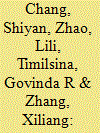| Srl | Item |
| 1 |
ID:
093516


|
|
|
|
|
| Publication |
2010.
|
| Summary/Abstract |
The Chinese government has enacted policies to promote alternative vehicle fuels (AVFs) and alternative fuel vehicles (AFVs), including city bus fleets. The life cycle (LC), energy savings (ES) and GHG reduction (GR) profiles of AVFs/AFVs are critical to those policy decisions. The well-to-wheels module of the Tsinghua-CA3EM model is employed to investigate actual performance data. Compared with conventional buses, AFVs offer differences in performance in terms of both ES and GR. Only half of the AFVs analyzed demonstrate dual benefits. However, all non-oil/gas pathways can substitute oil/gas with coal. Current policies seek to promote technology improvements and market creation initiatives within the guiding framework of national-level diversification and district-level uniformity. Combined with their actual LC behavior and in keeping with near- and long-term strategies, integrated policies should seek to (1) apply hybrid electric technology to diesel buses; (2) encourage NG/LPG buses in gas-abundant cities; (3) promote commercialize electric buses or plug-in capable vehicles through battery technology innovation; (4) support fuel cell buses and hydrogen technology R&D for future potential applications; and (5) conduct further research on boosting vehicle fuel efficiency, applying low-carbon transportation technologies, and addressing all resultant implications of coal-based transportation solutions to human health and natural resources.
|
|
|
|
|
|
|
|
|
|
|
|
|
|
|
|
| 2 |
ID:
116914


|
|
|
|
|
| Publication |
2012.
|
| Summary/Abstract |
China promulgated the Medium and Long-Term Development Plan for Renewable Energy in 2007, which included sub-targets of 2010 and 2020 for various renewable energy technologies. Almost all the 2010 sub-targets have been met and even surpassed except non-grain fuel ethanol. There is debate surrounding the questions of whether and how the country will be able to meet the 2020 biofuels target. This paper provides the assessment of potential technology pathways to achieve the 2020 target regarding their respective resource potential and supply cost. Barriers and policy options are identified based on broad literatures review. And an overview of biofuels projections is presented to provide insight into the comparison of various policy scenarios. The study shows that China can potentially satisfy non-grain fuel ethanol target by 2020 from technology perspective. But she will probably fall far short of this target if current situations continue. Additional policy efforts are needed. Meanwhile, the target of biodiesel production has high probability to be achieved. However, if given support policies, it will develop better.
|
|
|
|
|
|
|
|
|
|
|
|
|
|
|
|
| 3 |
ID:
116906


|
|
|
| 4 |
ID:
097202


|
|
|
|
|
| Publication |
2010.
|
| Summary/Abstract |
The rapid growth of vehicles has resulted in continuing growth in China's oil demand. This paper analyzes future trends of both direct and life cycle energy demand (ED) and greenhouse gas (GHG) emissions in China's road transport sector, and assesses the effectiveness of possible reduction measures by using alternative vehicles/fuels. A model is developed to derive a historical trend and to project future trends. The government is assumed to do nothing additional in the future to influence the long-term trends in the business as usual (BAU) scenario. Four specific scenarios are used to describe the future cases where different alternative fuel/vehicles are applied. The best case scenario is set to represent the most optimized case. Direct ED and GHG emissions would reach 734 million tonnes of oil equivalent and 2384 million tonnes carbon dioxide equivalent by 2050 in the BAU case, respectively, more than 5.6 times of 2007 levels. Compared with the BAU case, the relative reductions achieved in the best case would be 15.8% and 27.6% for life cycle ED and GHG emissions, respectively. It is suggested for future policy implementation to support sustainable biofuel and high efficient electric-vehicles, and the deployment of coal-based fuels accompanied with low-carbon technology.
|
|
|
|
|
|
|
|
|
|
|
|
|
|
|
|